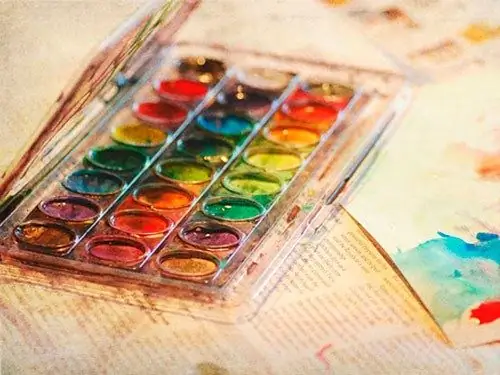Painting classes can bring harmony to a person's life, teach to see the beautiful in the ordinary, to know oneself and the world around him. And you can start drawing at any age, it is especially interesting to do it with watercolors.

It is necessary
- - watercolor;
- - watercolor paper / album;
- - squirrel brushes are round;
- - paper palette;
- - sponge;
- - water.
Instructions
Step 1
Before you start creating, especially if watercolor painting is a new experience for you, do some liberating exercises that will help you make friends with paint. Try your paints and brushes. Run the brush over the paper, applying paint thickly or almost transparently. Remove excess paint or water with a sponge. Try to make thin strokes and, conversely, thick ones, mix paints on a paper palette to get new shades. Learn to feel watercolor.
Step 2
Now draw a pencil sketch of your future work. Let it be a simple drawing - flowers, a landscape with a rainbow, or just an abstraction. The technique in which novice artists are recommended to work is called a la prima. This is one-touch paint application, easy without rubbing or shading. The most common mistake of neophyte artists is the appearance of paper pellets in the drawing precisely due to the excessive overlap of layers of paint.
Step 3
Master the technique of grisaille - this is the drawing of monochromatic works, often in black or brown. Choose a simple object as your nature. These can be fruits, geometric shapes, simple objects, etc. The technique teaches you to see the tone correctly, to work with chiaroscuro.
Step 4
Gradually moving from simple to complex, move on to drawing from nature in color. To do this, select a simple object for drawing, make a pencil sketch, then complete a one-color drawing - using the grisaille technique, and then in color. Through this exercise, you will learn how to work with watercolors with color, but also take into account the shape and volume of the object.
Step 5
The next step in working with watercolors is copying. Choose a reproduction and try to transfer what is depicted on it onto a sheet of paper. Keep in mind that copying will only be beneficial after learning the laws of drawing and painting. It is in this case that you will not just translate the image, mindlessly copying it, but deliberately repeat the stages of work, master new techniques and techniques of watercolor painting.






